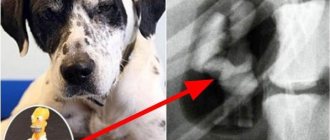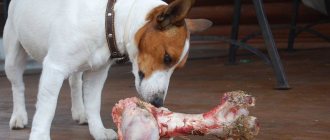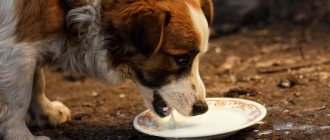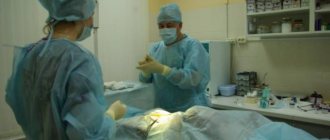One of the common causes of gastrointestinal damage in dogs is a foreign body that dogs ingest for various reasons. This can happen while playing, eating, or eating non-food items (for example, while walking). The main thing is to immediately provide help to your pet, otherwise serious consequences are possible, including asphyxia, soft tissue necrosis and peritonitis!
Read in this article:
What objects are most often swallowed by dogs? Symptoms that indicate your dog has swallowed a foreign object How can you tell where the foreign object is? What to do if your dog swallows a foreign body? General prognosis Diagnostics How is foreign objects removed? Useful tips
What objects are most often swallowed by dogs?
Most often, a dog swallows foreign bodies while walking, so it is recommended not to leave it alone and watch what it picks up from the ground. At home, it is recommended to keep all dangerous objects that the animal may accidentally swallow out of reach. These simple rules will help you avoid dangerous situations.
Items commonly swallowed by dogs:
- socks,
- rubber balls,
- plastic bags,
- stones,
- hair bands,
- bones,
- sticks,
- yarn and threads,
- Christmas tinsel,
- coins,
- hairpins, etc.
Veterinarians recommend carefully monitoring products that are used for preparing meat dishes, and therefore are imbued with the taste and smell of meat (sticks, baking bags, foil forms, etc.).
Signs that your dog has swallowed a foreign object
The first thing that should alert a dog owner is the frequent urge to vomit. Attacks of vomiting occur immediately or within 2-3 hours after eating (this depends on in which part of the digestive system the foreign object is located). At the same time, undigested food particles are present in the vomit.
General signs indicating the presence of a foreign body in a dog:
- loss of appetite or complete refusal to eat,
- strong thirst
- difficulty defecating (the dog bends and experiences discomfort when defecating, the volume of feces decreases, there may be blood in the stool),
- apathetic and lethargic state,
- dehydration of the body,
- aggressiveness (for example, with severe pain in the abdominal area),
- Constantly tense stomach.
The animal completely refuses food and water, internal bleeding, damage to internal organs as a result of the passage of a product with sharp edges (for example, glass), and general exhaustion of the body are possible.
If your dog is unwell and all signs indicate that it has swallowed a foreign object, contact a veterinary clinic in Moscow immediately! Do not self-medicate - this can lead to dangerous consequences not only for the health, but also for the life of your pet.
How do you know that eating bones was not in vain?
So, your dog has eaten skeleton fragments from the belly. How to understand that this was not in vain? The most typical symptoms are:
- Vomit.
- Loss of appetite.
- Abdominal pain.
- Difficulty with bowel movements.
Your first task when detecting any of these signs is to establish the “location”. Simply put, you need to find out exactly where the bone pieces are stuck.
If they are in the esophagus , signs appear soon after eating. At the same time, the dog constantly licks its lips, opens its mouth wide, vomits even from small amounts of food or water, and coughs. Pay attention to the vomit: it is “tubular”, consisting of food fragments molded together in the shape of the esophagus. Animals quickly begin to suffer from severe dehydration, as they are unable to drink normally. Since they also have problems with nutrition, exhaustion quickly develops.
How to understand where a foreign object is located?
Signs indicating that a dog has swallowed a foreign object differ depending on where it is located.
In the esophagus . If a foreign body enters the esophagus, the risk of blockage increases. Complete obstruction is accompanied by restless behavior of the pet, excessive salivation, frequent swallowing movements or attempts to perform them. With incomplete obstruction, the animal retains its appetite, but in any case, vomiting occurs when eating.
In the stomach . A characteristic sign that a foreign body has entered the stomach is irritation of the mucous membrane. Damage is possible even if the dog swallowed a blunt object rather than a sharp one. The presence of a foreign object in the stomach leads to a general deterioration in the pet’s condition, dehydration and, less often, to impaired bowel movements.
Small objects (such as parts of toys) can remain in the stomach for several years without causing any symptoms.
In the intestines. The fact that a foreign body is in the intestines is indicated by attacks of severe vomiting and pain in the abdominal area. Objects with blunt edges more often cause bloating and intestinal obstruction, while objects with sharp edges cause damage to the mucous membranes and blood in the stool. Added to this are signs of intoxication, general weakness and dehydration.
In the respiratory tract . If a foreign body enters the respiratory tract, the animal may die from asphyxia, so it requires emergency veterinary care! Please note that the animal exhibits shallow, jerky and heavy breathing. When transporting a dog to a doctor, it is necessary to ensure complete rest to avoid the development of serious complications.
When foreign bodies are swallowed, there is a high risk of complete or partial obstruction, torsion of the digestive tube, and the development of intestinal obstruction. If objects have sharp edges, internal bleeding often occurs and the mucous membranes are damaged, so the best solution is to immediately contact a veterinarian!
Veterinary assistance in treating a dog
In a veterinary hospital, the doctor seeks to determine the location of the bone. For this purpose, radiography is used with and without a contrast agent. Sometimes the dog undergoes an ultrasound, which online shows intestinal movement that is opposite to natural peristalsis. Once the location of the fragment and the degree of damage caused by it have been established, the veterinarian develops a treatment strategy.
Chicken bone in dog's throat
If the bone cannot be removed mechanically, the veterinarian will prescribe surgical or endoscopic removal of the stuck object.
Typically the bones become lodged in the pylorus or small intestine. Then the object is removed through an incision in the tissues of the organ. The situation is more complicated if the bone has to be removed along with part of the intestine. Resection has a more severe impact on the condition of dogs and requires a long recovery period.
If the bone is removed from the esophagus, the animal should not eat during the entire healing period so that the regeneration process proceeds faster. Subsequently, the dog will have to undergo a long postoperative recovery and adhere to strict guidelines. If the operation is successfully performed, the pet will ask to drink and get better the very next day.
To avoid injury to the animal from bone fragments, you must carefully monitor what the dog eats. These simple preventive measures will avoid the risk of severe damage to the animal's digestive system from sharp bone fragments or the risk of getting stuck.
How are dogs portrayed in cartoons and books? Here is the watchdog, and here is his bone, which he gnaws, taking breaks only for sleep and rest. But in reality, bones are not the best “treat” for these animals. Firstly, they have “0” nutritional value. Full. Secondly, when a dog has a bone stuck (even in its mouth) in the organs of the digestive system, its life will be in serious danger.
Chicken bones are especially “good” in this regard.
, leftover from grilled chicken, caught from soup, etc. That is, those that have undergone heat treatment. They become extremely fragile, and at the same time easily split into long and sharp fragments. Each of them can easily pierce the esophagus, stomach or intestines. Even in the mouth, such pieces can cause a lot of trouble.
Fish bones are a real killing tool.
Never, under any circumstances, feed them to dogs! They cause intestinal blockage and puncture and puncture internal organs. Very often, after such a “feast,” dogs have to be operated on or completely euthanized.
Perhaps the “safest” ones are boiled beef and pork haunches.
. True, their nutritional value is no more than that of sawdust. But even this variety has a tendency to split, so care should be taken in any case.
What to do if your dog swallows a foreign body?
The first thing to do is seek professional veterinary help. Immediately take your pet to an appointment with a veterinarian so that he can examine the pet, carry out diagnostics and perform all necessary procedures.
Under no circumstances should you:
- give your dog laxatives or antiemetics without the advice of a veterinarian,
- leave cleansing enemas on your own, because they can provoke further advancement of a foreign object and damage to internal organs,
- independently remove objects that the dog has swallowed (even if they are stuck in the throat or sticking out of the rectum!).
Make sure your dog is completely rested before visiting the veterinarian. It is strictly forbidden to feed or water the animal, as this leads to severe vomiting and dehydration of the entire body. In the future, follow all recommendations of the veterinarian.
The dog ate the bones. What should I do?
Let's assume that you didn't keep track, and your pet killed the bones left after a feast or picnic. What to do? If the animal behaves normally (that is, there is definitely nothing stuck in its organs), you can try to give it first aid. Its “events” are as follows:
- Having overcome disgust, carefully examine the feces
. If you see blood in it, or the dog groans and grunts with every bowel movement, take him to the vet immediately.
- You should also monitor your dog's behavior
. If your dog becomes moody or apathetic, take him to the clinic immediately.
- Fortunately, in most cases, severe consequences can be avoided by feeding your dog a little more bulky food
. A piece of bread and cooked rice (cold, of course) is ideal. They gently envelop the animal's intestines from the inside, preventing damage. If your pet doesn't like Japanese food, just mix rice, bread and his favorite treats. As a rule, after three to four days of such a diet, all the eaten bones come out naturally.
- even try to make your dog vomit!
Solid objects cannot be removed this way because they will almost certainly pierce the esophagus and get stuck halfway down.
General forecast
In more than 85% of cases the prognosis is favorable. It will be possible to remove the foreign object and restore the pet’s general well-being without consequences, if the presence of the foreign body does not lead to complete obstruction.
However, the specific forecast depends on the following factors:
- location of the foreign body after ingestion by the dog (in the stomach, esophagus, respiratory tract, etc.),
- size and shape of the object (blunt or with sharp edges, small or large, made of metal, plastic, etc.),
- general condition and age of the pet,
- the presence of complications that are already caused by ingestion of a foreign body.
Remember that the sooner you seek veterinary help, the higher your pet's chances of a full recovery. If you delay a visit to the doctor, complications may develop (intestinal damage, internal bleeding, peritonitis, soft tissue necrosis, etc.).
Diagnostics
An appointment with a veterinarian begins with an examination of the pet. Often, long objects (for example, ropes) are wound around the root of the tongue, so they can be immediately removed from the mouth, preventing further consequences.
Otherwise, in order to determine whether a dog has swallowed a foreign object and in which part it is located, the following methods are used:
- X-ray examination . An X-ray can reveal abnormal expansion, which indicates the presence of foreign objects in the digestive system, but only if they are radiopaque (for example, metal or wood). It is much more difficult to identify polyethylene or rubber products.
- Ultrasonography . It allows you to identify obstruction caused by external factors. Using an ultrasound machine, it is possible to determine the movement of a foreign body if the motor functions of the intestines and digestive system are completely preserved.
- Esophagogastroscopy . This is the most objective diagnostic method, allowing you to determine not only the presence of a foreign body, but also the consequences to which it led. Additionally, esophagogastroscopy helps to assess the condition of the mucous membranes in order, if necessary, to prescribe treatment to restore them.
Only after diagnosis, a veterinarian in Moscow prescribes treatment. It is selected individually for each pet, because it largely depends on its general condition and degree of dehydration.
What to do
If a dog has a bone stuck in its throat, you can pull it out by hand, or if that doesn't work, use a clamp or surgical tweezers. You need to act quickly and carefully so as not to push the bone further. To make the fragment easier to see, it is better to use a flashlight. The animal must be secured using a mouth speculum. After removing the bone, the dog’s mouth should be treated with a weak solution of potassium permanganate.
Many owners are concerned about the following questions: a bone is stuck in the dog’s throat - what to do, is it possible to do without surgical intervention?
Sometimes severe consequences can be avoided if you give the dog a large amount of food for several days, consisting of boiled rice, bread and, if necessary, the dog’s favorite treat.
This dish delicately envelops the intestines and prevents damage to the mucous membrane. Moving through the intestines, the food lump also captures bone fragments. As a rule, after 3-4 days, bone fragments come out naturally along with feces.
Sometimes the bone can be removed using the Heimlich method, the principle of which is to displace and push out the fragment:
- Place the dog on all fours, wrap your arms across its stomach.
- Make a fist with your right hand, with your thumb touching your chest.
- Cover your right hand with your left hand, making a lock.
- Press the dog's diaphragm several times with sharp movements from bottom to top.
If everything is done correctly, after 4-5 movements the bone will come out and you will be able to pull it out. However, in the absence of proper preparation, it is better not to experiment, since the accuracy of the movements is quite difficult to calculate.
Under no circumstances should you induce vomiting in your dog. It will not be possible to free yourself from large bones in this way; moreover, sharp fragments will pierce the esophagus.
A foreign body that has entered the stomach or esophagus cannot be removed at home, so you need to immediately take the dog to a veterinary clinic. Before examination by a specialist, to relieve muscle spasm and facilitate the movement of bone through the gastrointestinal tract, the dog can be given an injection of the drug “No-shpa” or Papaverine.
How is foreign objects removed?
Drug treatment . If a dog has swallowed a small object and it is in the esophagus, then emetics are used to remove it. They remove foreign bodies along with vomit. Vaseline oil is sometimes used to help push the object into the stomach. It is important that drug treatment is only suitable if the pet has swallowed a product with smooth edges (for example, a rubber ball).
Surgery . If emetics do not help or emergency intervention is required (for example, in cases where the pet has swallowed a sharp object), surgery is necessary. It is performed by laparotomy. After surgery, your pet needs rehabilitation. To restore his health, veterinarians administer 2-3 droppers. They contain vitamins and microelements, therefore they contribute to the overall strengthening of the body and prevent dehydration.
Useful tips
To prevent ingestion of foreign objects, choose only safe toys for your dog that cannot be chewed during play. Keep an eye on puppies in particular, because during the teething period they randomly chew and chew on everything around them.
Other useful tips to help avoid foreign bodies:
- Completely eliminate bones from your diet;
- Be careful while walking and make sure that the dog does not chew sticks, stones and other objects;
- Let your pet chew dried treats only in your presence, after removing all small pieces;
- Nail scissors, needles and other sharp or traumatic objects must be kept in a place where the animal cannot reach them;
- Try to spend more time training your dog so that it does not pick up anything, and if it does take something into its mouth, it spits it out immediately on your command.
And remember, your pet’s life is in your hands!










